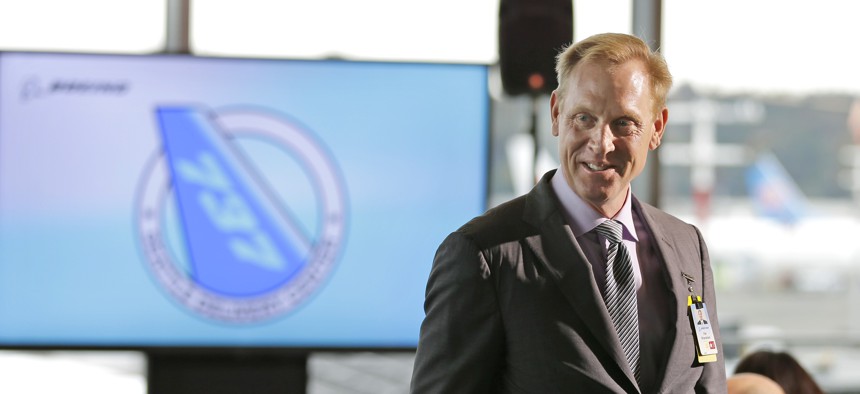
Pat Shanahan, then-senior vice president of Airplane Programs for Boeing Commercial Airplanes, greets guests at a re-opening ceremony for Boeing's newly expanded 737 delivery center in Seattle in 2015. Ted S. Warren/AP
Trump Picks ‘Mr. Fix-It’ to Run Daily Ops at Pentagon
Patrick Shanahan’s missile-defense background could prove important in a Trump administration.
Patrick Shanahan has been known to clean up troubled programs at Boeing. His portfolio is about to get much larger.
That’s because President Trump on Thursday said he would nominate Shanahan — currently the senior vice president of supply chain and operations at the Chicago-based aerospace and defense giant — to become deputy defense secretary.
“He was a make-it-happen kind of guy at Boeing,” said Arnold Punaro, a retired Marine major general and former Senate Armed Services Committee aide.
Shanahan would replace Bob Work, a retired Marine Corps colonel who has been in the job for almost three years.
A 2008 Los Angeles Times profile about Shanahan said he is known as “Mr. Fix-It” within Boeing, where he “quietly turned around some of [the company’s] most-troubled and complex programs.”
While the defense secretary is traditionally the Pentagon’s face, traveling around the world, and attending “outside” functions, the deputy is the “insider,” managing the day-to-day operations at the Pentagon. This means overseeing the military’s $600 billion budget and $1.6-trillion weapons portfolio.
Shanahan will likely help implement the “ambitious reform agenda to build a military that is as effective and efficient as possible,” as it was described Thursday in a White House’s budget blueprint for Trump’s presidency. The document said Trump wants “to reduce the costs of military programs wherever feasible.”
An engineer with advanced degrees from the Massachusetts Institute of Technology, Shanahan has worked in a number of executive positions across Boeing’s defense and commercial airplanes divisions.
He has overseen all of the company’s rotorcraft programs: the V-22 Osprey tiltrotor, the CH-47 Chinook, and the AH-64D Apache attack helicopter. He also ran the company’s missile defense programs, most notably the interceptors in Alaska.
In 2007, he moved to the commercial side of Boeing’s house, overseeing the then-troubled 787 Dreamliner program before becoming senior vice president of Airplane Programs in late 2008. In that role he “oversaw the management of profit and loss for the 737, 747, 767, 777 and 787 programs,” according to his official company biography.
Boeing leaped onto Trump’s radar screen within weeks of winning the election. In December, the president-elect blasted the company in a tweet that appeared to pull as-yet-unknown cost of the next Air Force One out of thin air. But later, Trump began to tout the 4.5th-generation Boeing F/A-18 Super Hornet fighter as an alternative to Lockheed Martin’s 5th-gen F-35 Joint Strike Fighter. And just last month, the president visited a Boeing 787 factory in Charleston, South Carolina, where he concluded his remarks with the line “God bless Boeing.”
If confirmed by the Senate, Shanahan would need to divest his Boeing holdings and likely need to recuse himself from Pentagon decisions involving Boeing for at least a year, Punaro said. Such decision include whether to buy more Super Hornets, Air Force One, and a new refueling tanker the company is building for the Air Force.
But Shanahan expertise and background could still be relied upon, particularly in missile defense, which the Trump administration has touted on the White House website since January.
“This suggests that the administration is likely to take the missile defense mission very seriously,” said Thomas Karako, a missile defense expert at the Center for Strategic and International Studies.
Shanahan’s missile defense expertise is particularly focused on homeland defense. He oversaw Ground-based Midcourse Defense, a system designed to intercept missiles fired at the United States.
“I suspect this is going to be a good year for some good thinking about homeland missile defense,” Karako said.
Choosing a executive from the private sector is common among two of the past five deputy defense secretaries.
President Obama’s first deputy secretary Bill Lynn — who held a number of senior Pentagon posts in the 1990s — was senior vice president of government operations and strategy at Raytheon before returning to the Defense Department in 2009. Gordon England held held a number management and executive posts at General Dynamics before becoming George W. Bush’s deputy defense secretary.




